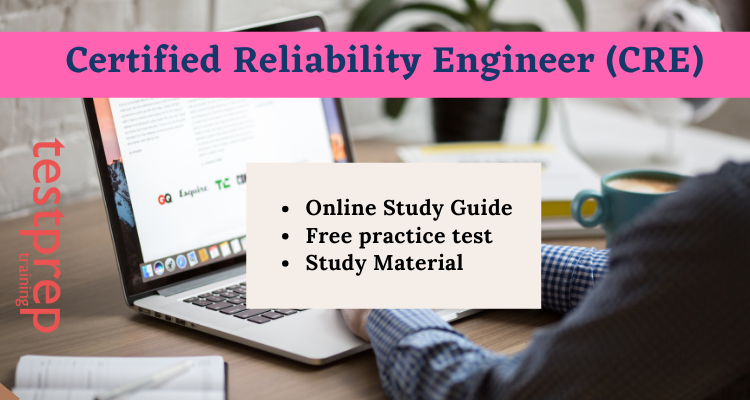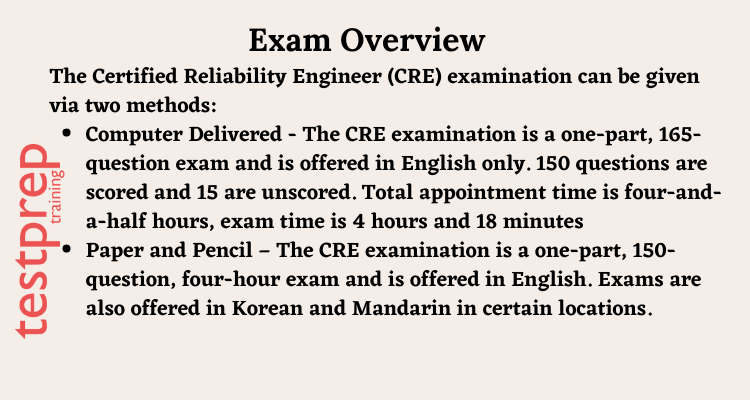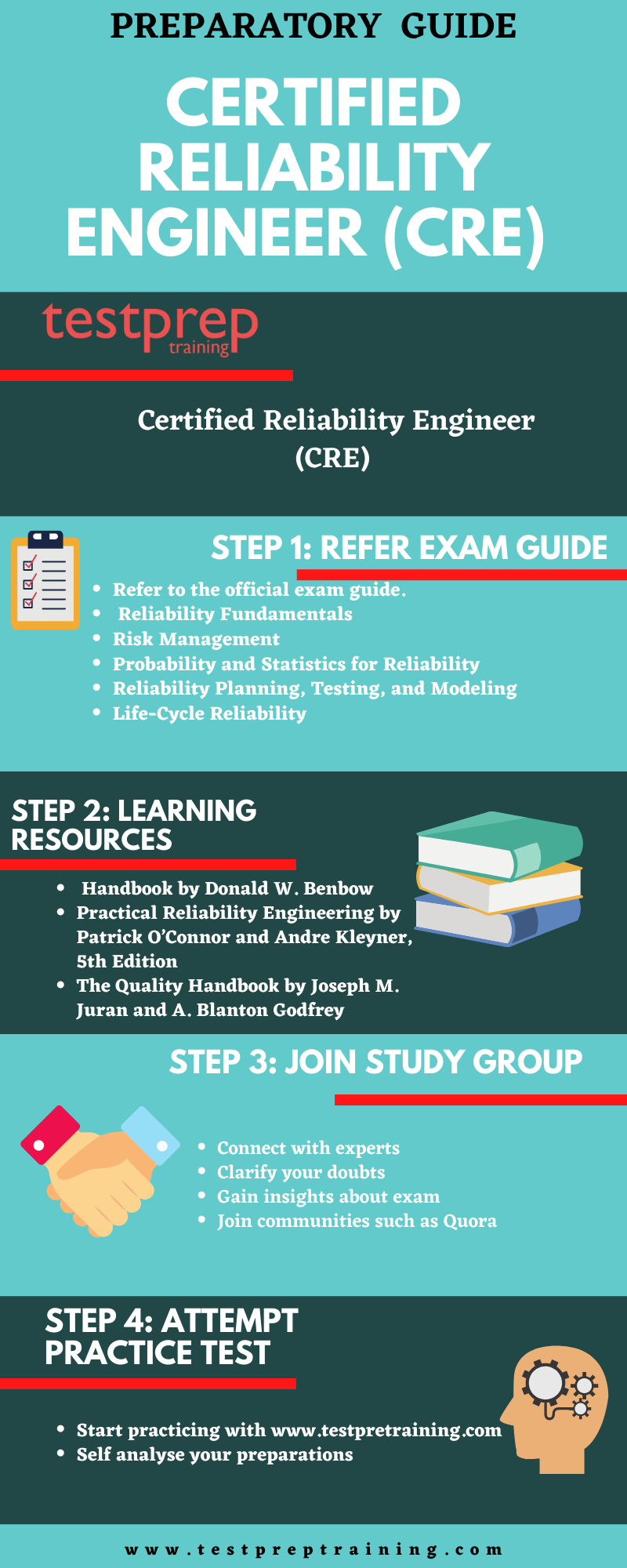Certified Reliability Engineer (CRE)

A Certified Reliability Engineer is a person who knows how to evaluate and anticipate performance in order to improve the safety, reliability, and maintainability of products and systems.
This Body of Knowledge (BOK) and the technologies used include, but are not limited to, design review and control; Forecasting, estimation and apportionment methodology; Effects and analysis of possible errors; the planning, execution and analysis of reliability tests and field failures, including mathematical modeling; Understand the human factors related to reliability; and the ability to develop and manage reliability information systems for failure analysis, performance design and improvement, and reliability program management throughout the product life cycle.
Key Exam Requirements
Work Experience
Candidates must have had a full-time, salaried position. Paid internships, co-ops, and other coursework do not count toward the required job experience. Candidates with prior ASQ certifications as a quality engineer, quality auditor, software quality engineer, or quality manager will find that their expertise qualifies them for certification as a reliability engineer.
Education
Part of the eight-year experience requirement will be waived for candidates who have obtained a degree from a college, university, or technical school, as follows (only one of these waivers may be claimed):
- Diploma from a technical or trade school — one year waived
- Associate degree — two year waived
- Bachelor’s degree — four years waived
- Master’s or doctorate — five years waived
Exam Overview
The Certified Reliability Engineer (CRE) examination can be given via two methods:
- Computer Delivered – The CRE examination is a one-part, 165-question exam and is offered in English only. 150 questions are scored and 15 are unscored. Total appointment time is four-and-a-half hours, exam time is 4 hours and 18 minutes
- Paper and Pencil – The CRE examination is a one-part, 150-question, four-hour exam and is offered in English. Exams are also offered in Korean and Mandarin in certain locations.

Exam Registration
Follow these steps to successfully register yourself for the examination:
- Go to the official ASQ website, or click on the Certified Reliability Engineer (CRE) guide.
- On the left-hand side of the page, you may see a box, click on apply now. The candidate can choose a date between any of the dates mentioned.
- Login in to your ASQ account or create a new account on ASQ and follow the prompt.
- Post submitting the application, it takes 1-2 business days to review the online applications and 3-5 for hardcopy applications.
- After ASQ completes the review process you will receive an approval notification via email or a “hold” message explaining that more information is needed for your application to be approved. If it is determined that you do not meet exam requirements, you will receive a refund minus a $70 processing fee.
- Computer-Based Testing, CBT:
1-2 business days after you receive your approval notification, you will receive an eligibility email containing instructions on how to schedule your exam with our testing provider Prometric. - Paper-Based Testing, PBT:
If you have registered for a Paper-based or translated exam you will not receive an eligibility email. Instead, you will receive a seating letter with your exam date, time, and location approximately 2 weeks before your exam date. - Schedule your exam appointment in the testing window you chose at the time of application.
For more information, click on the Certified Reliability Engineer (CRE) FAQ.
Course Outline
The Certified Reliability Engineer (CRE) examination covers the following topics:
I. Reliability Fundamentals
A. Leadership Foundations
- Benefits of reliability engineering: Describe the value that reliability has on achieving company goals and objectives, and how reliability engineering techniques and methods improve programs, processes, products, systems, and services.
- Interrelationship of safety, quality, and reliability: Describe the relationship of and distinguish between reliability and quality, and describe the importance of safety in reliability engineering and how reliability impacts safety.
- Reliability engineer leadership responsibilities: Describe how to be a reliability champion by influencing program decisions and facilitating cross-functional communication.
- Reliability engineer role and responsibilities in the product life cycle: Describe how the reliability engineer influences the product life cycle, and describe a reliability engineer’s role in the design review process in order to anticipate how reliability can impact risk and costs, and ensure performance over time.
- Function of reliability in engineering: Describe how reliability techniques can be used to apply best practices in engineering (e.g., measuring reliability early), how industry standards can impact reliability, and how reliability can inform the decision analysis process.
- Ethics in reliability engineering: Identify appropriate ethical behaviors for a reliability engineer in various situations.
- Supplier reliability assessments: Explain how supplier reliability impacts the overall reliability program and describe key reliability concepts that should be included in supplier reliability assessments.
- Performance monitoring: Describe the importance of performance monitoring to ensure that product reliability or safety requirements continue to be met, and identify life-cycle points in which process and product reliability data are collected and evaluated.
B. Reliability Foundations
- Basic reliability terminology: Explain basic terms related to reliability and the associated metrics (e.g., MTTF, MTBF, MTTR, service interval, maintainability, availability, failure rate, reliability, and bathtub curve).
- Drivers of reliability requirements and targets: Describe how customer expectations and industry standards, safety, liability, and regulatory concerns drive reliability requirements.
- Corrective and preventive action (CAPA): Identify corrective and preventive actions to take in specific situations and evaluate their measures of effectiveness.
- Root cause analysis: Describe root cause analysis, and use a root cause and failure analysis tool to determine the causes of degradation or failure.
- Product life-cycle engineering stages: Describe the impact various life-cycle stages (concept/design, development/test, introduction, growth, maturity, decline) have on reliability, and the cost issues (product maintenance, life ex-pectation, software defect phase containment, etc.) associated with those stages.
- Economics of product maintainability and availability: Describe the cost tradeoffs associated with product maintainability strategies and availability.
- Cost of poor reliability: Describe how poor reliability affects costs over the life cycle.
- Six Sigma methodologies: Describe how Six Sigma principles support reliability engineering.
- Systems engineering and integration: Describe the role of reliability engineering within systems engineering, including the integration of components and their interfaces/interactions within the system.
II. Risk Management
A. Identification
- Risk management techniques: Use risk management tools and processes to identify, document, and track concerns. Identify and prioritize safety, economic, performance, and customer satisfaction concerns utilizing an appropriate risk management framework.
- Types of risk: Identify the various types of risks, including technical, scheduling, safety, and financial, and describe their relationship to reliability.
B. Analysis
- Fault tree analysis (FTA): Use fault tree analysis (FTA) techniques to evaluate product or process failure.
- Failure mode and effects analysis (FMEA): Define and distinguish between failure mode and effects analysis (FMEA) and failure mode, effects, and criticality analysis (FMECA) and apply these techniques to systems, products, processes, and designs.
- Common mode failure analysis: Describe common mode failure (also known as common cause failure) and how it affects risk.
- Hazard analysis: Describe how hazard analysis informs the development process, and how information obtained as a result of the hazard analysis is used by the reliability engineer.
- System safety: Identify safety-related issues by analyzing customer feedback, design data, field data, and other information. Prioritize safety concerns, and identify steps that will minimize the improper use of equipment, products, or processes.
C. Mitigation
- Identify appropriate risk mitigation (treatment) plans to include controls that will minimize risk and subsequent impact in terms of safety, liability, and regulatory compliance.
III. Probability and Statistics for Reliability
A. Basic Concepts
- Firstly, Basic statistics: Define various basic statistical terms (e.g., population, parameter, statistic, sample, the central limit theorem, parametric, and nonparametric), and compute and interpret their values
- Next, Basic probability concepts: Use basic probability concepts (e.g., independence, mutually exclusive, conditional probability), and compute and interpret the expected values.
- Probability Distribution: Compare and contrast various distributions (e.g., binomial Poisson, exponential, Weibull, normal, and log-normal), and recognize their associated probability plots.
- Probability functions: Compare and contrast various probability functions (e.g., cumulative distribution functions (CDFs), probability density functions (PDFs), and hazard functions), and recognize their application in various situations.
- Sampling plans for statistics and reliability testing: Use various theories, tables, and formulas to determine appropriate sample sizes or testing time for statistical and reliability testing.
- Statistical process control (SPC) and process capability studies (Cp, Cpk): Define and describe SPC and process capability studies (Cp, Cpk, etc.), control charts, and how each is related to reliability.
- Confidence and tolerance intervals: Compute confidence intervals and tolerance intervals, draw conclusions from the results, and describe how point estimates are used to determine the interval.
B. Data Management
- Sources and uses of reliability data: Describe sources of reliability data (prototype, development, test, field, warranty, published, etc.), their advantages and limitations, and how the data can be used to measure and enhance product reliability.
- Types of data: Identify and distinguish between various types of data (e.g., attributes vs. variable, discrete vs. continuous, censored vs. complete, and univariate vs. multivariate). Select appropriate analysis tools based on the data type.
- Data collection methods: Identify and select appropriate data collection methods (e.g., surveys, automated tests, automated monitoring, and reporting tools) in order to meet various data analysis objectives and data quality needs.
- Data summary and reporting: Examine collected data for accuracy and usefulness. Analyze, interpret, and summarize data for presentation using various techniques, based on data types, sources, and required output.
- Failure analysis methods: Describe failure analysis tools and methods (e.g., mechanical, materials, physical analysis, and scanning electron microscopy (SEM)) that are used to identify failure mechanisms.
- Failure reporting, analysis, and corrective action system (FRACAS): Identify elements necessary for FRACAS, and demonstrate the importance of a closed-loop process.
IV. Reliability Planning, Testing, and Modeling
A. Planning
- Reliability test strategies: Develop and apply the appropriate test strategies (e.g., truncation, test-to-failure, degradation, growth plan, and test, analyze, and fix (TAAF)) for various product development phases.
- Environmental and conditions of use factors: Identify environmental and use factors (e.g., temperature, humidity, and vibration) and stresses (e.g., severity of service, electrostatic discharge (ESD), throughput, and duty cycle) to which a product may be subjected.
- Failure consequence: Describe the importance of identifying the consequences of failure modes when establishing reliability acceptance criteria.
- Failure criteria: Define and describe failure criteria based on system requirements and warranty terms and conditions.
B. Testing
- Firstly, Describe the purpose, advantages, and limitations of each of the following types of tests, and use common models to develop test plans, evaluate risks, and interpret test results.
- Secondly, Accelerated life tests: single-stress, multiple-stress, sequential stress, step-stress, HALT, margin tests)
- Stress screening: (ESS, HASS, burn-in tests)
- Next, Qualification/Demonstration testing: (sequential tests, fixed-length tests)
- Degradation (wear-to-failure) testing
- Software testing: (white-box, black-box, operational profile, and fault-injection)
C. Modeling
- Reliability block diagrams and models: Generate and analyze various types of block diagrams and models, including series, parallel, partial redundancy, and time-dependent.
- Physics of failure and failure mechanisms: Identify various potential failure mechanisms (e.g., fracture, corrosion, memory corruption) and describe the physical process of these failures.
- Failure models: Select appropriate theoretical models (e.g., Arrhenius, S-N curve) to assess or predict failure rates.
- Reliability prediction methods: Use various reliability prediction methods (e.g., Monte Carlo Simulation, part stress analysis, and parts count prediction) for both repairable and nonrepairable components and systems, and describe the inputs into the model
- Design prototyping: Describe the advantages and limitations of prototyping to enhance product reliability.
V. Life-Cycle Reliability
A. Reliability Design Techniques
- Stress-strength analysis: Apply the stress-strength analysis method of calculating probability of failure, and interpret the results.
- Design of experiments (DOE): Develop and interpret the results of a standard design of experiments (DOE) (e.g., full factorial and fractional factorial).
- Reliability optimization: Use various approaches to optimize reliability within the constraints of cost, schedule, weight, and other design requirements.
- Human factors: Describe the relationship between human factors and reliability engi-neering, including user safety, user and usage profiles, failure modes, and mechanisms.
- Design for X (DFX): Apply DFX techniques such as design for manufacturability, testability, and maintainability.
- Design for Reliability (DfR): Apply DfR in order to meet reliability requirements throughout the product or system life cycle. Understand how built-in reliability and fault tolerance/avoidance are key goals for design for reliability.
B. Parts and Systems Development
- Materials and components selection techniques: Apply techniques (e.g., derating and commercial off-the-shelf (COTS)) for selecting materials and components to meet reliability goals and requirements.
- Parts standardizationand system simplification: Parts standardizationand system simplification.
C. Maintainability
- Maintenance strategies: Develop a maintenance plan incorporating various strategies (e.g., predictive maintenance, repair or replace decision making, spare parts analysis/forecasting, and equipment warranties).
- Preventive maintenance (PM) analysis: Define and use PM tasks, optimum PM intervals, and other elements of this analysis. Identify situations when PM is not effective.
- Corrective maintenance analysis: Describe and apply the elements of corrective maintenance analysis.
Preparatory Guide for Certified Reliability Engineer (CRE)
To succeed on the exam, you must have all of the exam preparation resources, including the study guide. This may appear to be a simple task, but having complete exam details and appropriate learning resources will be the only way to pass the exam. To begin our preparation, let’s go over them one by one.

Refer the Exam Guide
The first step is to obtain a copy of the Certified Reliability Engineer (CRE) exam guide. This exam guide contains accurate information on the exam course. Remember to consult the exam guide to gain a thorough understanding of your course. Make sure you’re familiar with the course concepts as well. Before beginning your exam preparations, you need have a comprehensive understanding of the exam specifics, hence the official guide is a requirement.
- Reliability Fundamentals
- Risk Management
- Probability and Statistics for Reliability
- Reliability Planning, Testing, and Modeling
- Life-Cycle Reliability
Books and Guides
When it comes to studying for any exam, books have always been the most favoured resource. They are an invaluable resource for gaining a thorough understanding of the subject. For the preparation of the Certified Reliability Engineer (CRE) exam, there are numerous publications available on the market. From the abundance of selections, choose the books that best fit you. Here is a selection of books that you should read as part of your preparations:
- The Certified Reliability Engineer Handbook by Mark Allen Durivage
- The Certified Reliability Engineer Handbook by Donald W. Benbow
- Practical Reliability Engineering by Patrick O’Connor and Andre Kleyner, 5th Edition
- The Quality Handbook by Joseph M. Juran and A. Blanton Godfrey
Join Community
Online discussion boards and study groups are excellent resources for preparing for the certification exam. As a result, use study forums to connect with other applicants and gain insight into their experiences.
Networking, material sharing, and peer-to-peer learning are all possible in myASQ groups. Some of these communities are password-protected, and your membership status is determined by your profile.
Self Evaluate with Practice Tests
Practice makes a man perfect, as we all know. Practice exams should be included in your study guide. It assists you in reviewing your preparations and identifying your weaker areas. Strengthening these areas will almost certainly result in success. Also, take as many tests as possible. The more you practise, the more proficient you will become. Begin practising right away!


